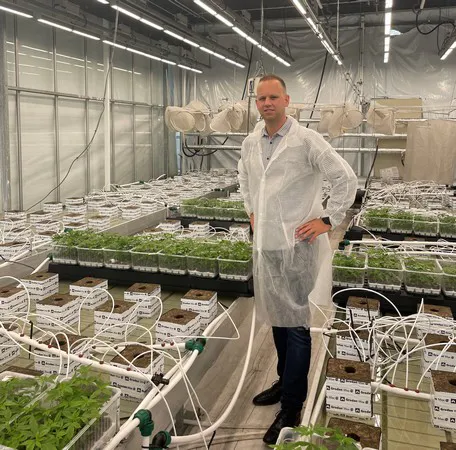Vertify, the World Horti Center (WHC), and cultivators specializing in cannabis and vertical farming have formed a consortium under the name “Cultivation for Compounds” to research the compounds in horticultural crops, beginning with medicinal cannabis. Within the greenhouse complex of Vertify and the WHC, two compartments of 100 m2 each have been equipped with cultivation tables, LED grow lights, high-pressure fogging equipment, and AVS-C air handling units.
“The license has been finalized, and the first trial crop is already done,” says Cultivators’ Sonny Moerenhout, speaking for the new consortium. “We are ready to work with partners to set up and carry out crop trials. The emphasis is on research questions about the compounds found in specific crops. Cannabis may be the best-known and most current example of this, but if it’s up to us, it won’t stop there.”

Compounds
Whether it concerns the medicinal or recreational use of cannabis, it is especially important to growers that the harvested product – the flowering buds – contains stable, preferably high levels of the compounds that make the product valuable.
“Cannabinoids include a complex of chemical compounds, such as CBD, CBG, and THC,” Moerenhout explains. “Depending on the purpose of use, growers are looking for specific levels of each component. In addition, the flavors present – predominantly terpenes – have a major impact on how the product is experienced when it is consumed. For cannabis growers and processors, it is important to have a grip on these and other compounds. After all, you want to deliver a product of consistent quality. That turns out to be quite difficult in practice, partly due to genetic instability.”
Cultivation license only
The research license granted by the Dutch government is limited to the cultivation and drying of cannabis buds. “Any processing of the buds is out of scope for us,” emphasizes the crop expert. “After growing, harvesting, and drying the buds, the plant material will be destroyed.”
However, that doesn’t get in the way of the researchers’ work. “Our added value is precisely that by playing with climate, light, watering, and fertilization, we gain more insight into how the compounds are produced, their ratios, and differences between varieties under specific conditions. The results will help improve growth recipes and contribute to more informed advice. Ongoing trials are discussed weekly with the research partners involved.”
Climate control and dehumidification
Cannabis cultivation is intensive and requires a considerable input of heat, light, water, and CO2. For the cultivation research focused on cannabis compounds, Cultivation for Compounds has provided cultivation tables for two research compartments in the Vertify/WHC greenhouse complex. AVS-C active ventilation units with central heating blocks have been installed in both facades, primarily for extracting and removing moisture from the greenhouse air.
Cannabis is a fast-growing crop that transpires a lot of water. The crop takes about ten weeks, divided into two weeks of vegetative growth at a day length of 18 hours and eight weeks of generative growth at a day length of 12 hours.
“We can control the day length with screens, and the dimmable, flexible light installation can provide up to 1,400 μmol/m2/sec of extra PAR light in variable colors. As a result, the control range is extraordinarily broad,” says Moerenhout.
Working principle of AVS-C
The AVS-C units play an important role in moisture and temperature control. They can ventilate internally and thus keep the crop active, as well as draw in relatively dry outside air, preheat it if desired, and mix it with greenhouse air to reduce the moisture content. The drier air is blown into the greenhouse at the desired temperature through air distribution hoses under the cultivation tables to create a good, homogeneous greenhouse climate. “Active dehumidification is really necessary for this crop because, in the growth phase, the crop can transpire twice as much water at night as a tomato crop. This kind of system is no unnecessary luxury, especially when the screens are closed.”
For more information: World Horti Center
World Horti Center
Europa 1
2672 ZX Naaldwijk
Netherlands
+31 (0)174 385 600
[email protected]
www.worldhorticenter.nl
